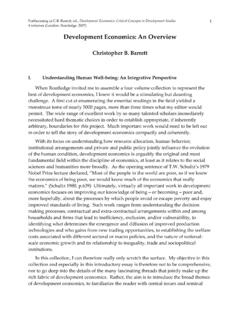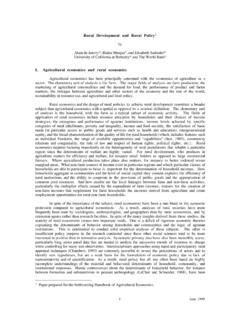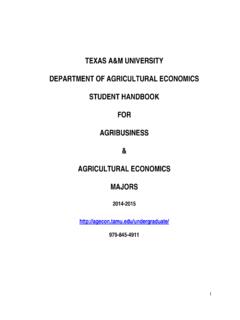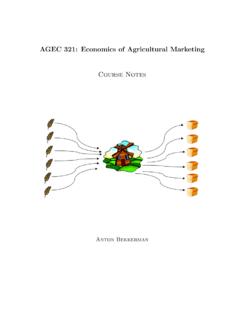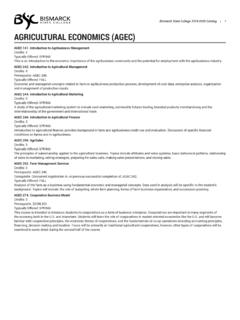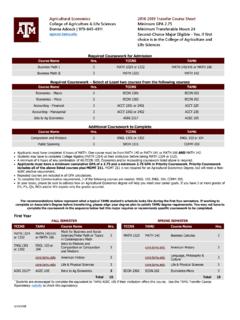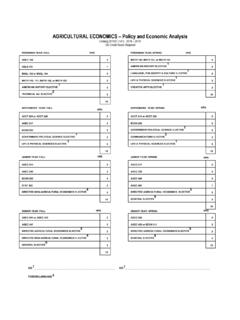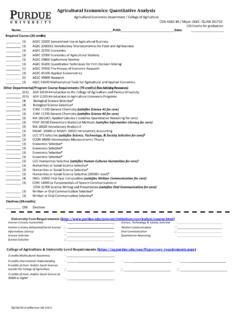Transcription of The Economics of Agricultural Development: An Overview 1
1 The Economics of Agricultural development : An Overview1 Christopher B. Barrett I. Agricultural development : The Gateway to Improved Standards of Living Virtually all past cases of rapid, widespread economic development have been causally associated with the transformation of Agricultural systems, from 18th and 19th century Europe and North America to late 20th century east Asia. Striking increases in Agricultural productivity, improvements in food processing and storage, and markedly reduced costs of food distribution improved the quantity, quality, safety and variety of food available at lower prices. Through these advances, Agricultural development permitted historically unprecedented growth in incomes, increased life expectancy, decreased the risk of chronic or acute malnutrition and enabled increased investment in education and non- Agricultural activities in today s advanced economies. Failure to achieve such improvements is strongly associated with the development failures of the poorest economies in the world today.
2 Hence the opening sentences of Schultz s 1979 Nobel Prize lecture: Most of the people in the world are poor, so if we knew the Economics of being poor, we would know much of the Economics that really matters. Most of the 1 This essay draws heavily on Barrett, Carter and Timmer (2010) and has benefited enormously from conversations on this topic over the years with Michael Carter, Jean-Paul Chavas, Alain de Janvry, Bob Herdt, Per Pinstrup-Andersen, Tom Reardon, Peter Timmer and the late Vern Ruttan. I thank them for the many lessons they have taught me; any errors of fact or interpretation in this essay are entirely mine, however. - 2 - world s poor people earn their living from agriculture, so if we knew the Economics of agriculture we would know much of the Economics of being poor (Schultz 1980, ). Schultz famously observed that until communities and countries made scientific and institutional advances to reliably meet their subsistence food needs through improved production, processing and trade, few could begin the process of modern economic growth.
3 Understanding the process of Agricultural development is therefore central to most contemporary research and advanced study in Agricultural Economics and development Economics , in international development , in related social science subdisciplines such asanthropology, geography and sociology, and even in much of the Agricultural sciences more broadly. The broad reach of this topic arises because research on Agricultural development has long operated at the intersection of distinct subdisciplines in Economics , other social sciences (especially anthropology, geography and sociology), and biophysical Agricultural sciences. Today, virtually every college and university in the world teaches undergraduate and/or graduate courses in Agricultural development , typically in a department of Agricultural Economics or Economics . Many schools of international relations, public policy, development studies, agriculture, etc.
4 Likewise include programs in Agricultural development . Interest in the field is especially intense and growing, for obvious reasons, in the emerging economies of Africa, Asia, Latin America, and Central and Eastern Europe that still rely relatively heavily on Agricultural development to ignite their own economic growth, international trade and poverty reduction. Agricultural development is thus a field of many disciplines, but Economics has provided the main intellectual framework for analysis of what policies to follow that will speed the process of raising rural productivity and well-being. This four volume collection of seminal readings is therefore rooted in the Economics of Agricultural development . - 3 - Agricultural development is a relatively young field of scholarly inquiry. Serious interest began in the 1950s as independence movements in the Third World gathered steam, leading to a veritable explosion of research in the 1960s that established Agricultural development as a powerful and influential field in the social and Agricultural sciences.
5 Following some waning interest in the 1980s and 1990s, the field has enjoyed a renaissance over the past decade especially in the wake of the 2007-8 global food price crisis as scholars and policymakers have increasingly recognized that there remain few firmly established dogmas and many unanswered questions. The realm of the unknown is so large because the reality of Agricultural development on the ground is so complex, encompassing production and agroecological issues, post-harvest processing and distribution questions, and a wide array of economic and political institutional arrangements. Enormous progress has been made since the 1950s in documenting and understanding this complexity, although these issues breadth and unsettled state lead to considerable ongoing intellectual activity in Agricultural development . To be sure, we know a lot more than we did even fifty years ago. But it is sobering to read the classics from the early 1960s and realize how relevant many of their insights remain.
6 Much of what was not known then remains unknown today. This edited set surveys the literature in this vast field, structuring the presentation around four broad themes. The first volume revolves mainly around macro-scale issues of Agricultural development at the national and global scales, addressing intersectoral spillovers, the relation between agriculture and sectoral and macroeconomic policies, the political economy of agriculture, and international trade in Agricultural products. The second volume focuses on the microeconomics of markets and institutions, which are crucial to Agricultural development as an ever-shrinking number of farmers strive to feed an ever-rising population of non-farm - 4 - consumers. We review the wide array of arrangements under which producers secure essential inputs such as labor, land and credit, and by which they supply surpluses into the Agricultural marketing channel.
7 The third volume is structured around the theme of farm-level productivity growth, emphasizing the role of technological innovation and diffusion and risk management in successful Agricultural development through growth in land, labor and total factor productivity. The fourth volume explores the post-harvest distributional impacts of Agricultural development , exploring how Agricultural development affects poverty, food insecurity and the intra-household distribution of well-being. Economists of all stripes have made fundamental contributions to the field of Agricultural development . So I have had to be ruthlessly and sometimes admittedly arbitrarily selective in narrowing the hundreds of candidate articles and book chapters down to the 66 that follow this introductory essay. Necessarily and regrettably, I had to omit much important work especially longer pieces that are difficult to fit into a set with a page ceiling in order to tell the story of the Economics of Agricultural development compactly and (hopefully) coherently.
8 It is therefore important for readers to appreciate that this collection really only scratches the surface. My objective in this collection and especially in this introductory essay is not to be comprehensive, nor to go deep into the details of the many fascinating threads that jointly make up the rich fabric of the Economics of Agricultural development . Even important works are mentioned only in passing. Rather, the aim is to introduce the broad themes of the topic, to familiarize the reader with central issues and seminal findings that have guided the field s evolution over the past half century or so, to flag several dozen seminal readings for those who wish to plumb particular sub-topics in greater detail, and to use the references lists of those readings and this introductory essay as a gateway for students who wish to engage the topic in - 5 - greater depth. My aspiration is that this set kindles interest in students and younger scholars so that they will dive more deeply into the luxurious pool of economic research on Agricultural development .
9 II. Agricultural development and economic Growth We start with the big question: the role of agriculture in the broader process of economic growth and development . This macro perspective introduces key linkages between the Agricultural sector and the rest of the economy, often via the rural non-farm economy, and pursues the dynamic evolution of structural transformation. The economic and demographic pathways inherent in this transformation present strategic challenges and opportunities to development policymakers, which leads as well to a discussion of the political economy of Agricultural policy design and implementation during the structural transformation. And the tremendous heterogeneity of countries experience of productivity growth and the pace of Agricultural development (Mundlak 2000, chapter 3) binds these issues closely to associated questions of global poverty and food insecurity (Dercon 2009, chapter 9).
10 Agricultural development as an analytical topic, with Economics as an organizing framework, dates to the rapid emergence of Western Europe from the late 18th century. economic historians have documented the critical role of agriculture in the development of virtually all the now-rich countries in the world, an experience drawn upon by W. Arthur Lewis when he wrote: industrial and agrarian revolutions always go together, and .. economies in which agriculture is stagnant do not show industrial development (Lewis 1954, p. 433). A. Inter-sectoral Linkages and Agriculture in the Macroeconomy - 6 - These insights by Lewis stimulated three lines of thought about the role of agriculture in economic development . First, the direct outgrowth of Lewis analysis of dual economies was formal two-sector modeling (Ranis and Fei 1961, chapter 4; Jorgenson 1961, chapter 5), with its focus on structural changes.
